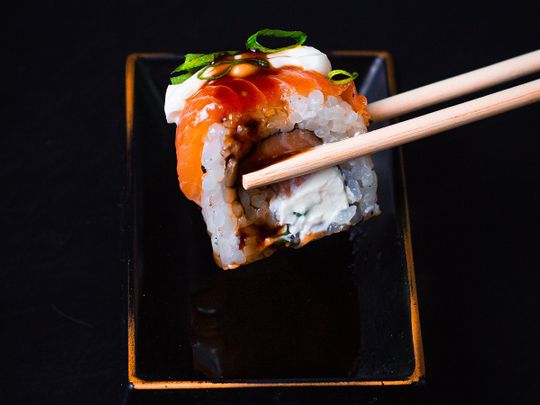
Sushi – a global favourite – has been around for a surprisingly long time, and its origin story is surrounded by legends and folklore.
Click start to play today’s Crossword and spot sushi in one of the clues. Check out Gulf News’ Food section for recipes, guides, and more.
According to an ancient Japanese tale, an elderly woman began hiding her pots of rice in the nests of ospreys, in an attempt to hide them from thieves. When she later collected her pots, she found the rice had begun to ferment. Not only that, fish scraps from the ospreys’ meals had mixed into the rice. The woman tried it and found that the combination wasn’t just tasty, the rice served as a perfect way to preserve the fish – and so began a whole new way of extending the shelf-life of seafood.
While it’s a charming folk tale, we now know that the first forms of sushi originated in China – mentions of it have been found in texts from the second century AD. People would place fish in rice and allow it to ferment, so that the fish could be edible for some time. They would then throw the rice away and eat the fish. This technique travelled to Japan in the seventh century, where citizens took it a step further and began to eat the rice with the fish.
The Japanese took to sushi with gusto. In the eighth century AD, sushi was so highly prized in Japan that people were allowed to use it to pay their taxes!
Japan was also responsible for changing the face of sushi, and bringing it closer to how we plate it today. In the early 17th century, a physician named Matsumo Yoshiichi of Edo (now known as Tokyo) began seasoning the rice with vinegar while preparing sushi. This way, the dish could be eaten immediately, instead of waiting for months for it to ferment.
As the preparation of sushi became easier, it became one of the most popular street foods in the country and was primarily how people gained access to the meal. Then, an earthquake in 1923 caused land prices in Japan to decline. It allowed street vendors to upgrade – they swapped their street stalls for brick-and-mortar establishments. By the 1950s, sushi could be found in restaurants that had popped up all across Japan.
The addition of new ingredients became a quintessential part of the way sushi was prepared and eaten. Wasabi, for instance, which generates heat from antimicrobial chemicals in the plant, was used to kill any parasites and microbes in the raw fish used in sushi. Today, even though seafood is usually flash-frozen to rule out the fear of parasites, wasabi paste is still traditionally served with a plate of sushi.
Today, sushi is still evolving, with modern chefs introducing new ingredients, preparation and serving methods around the world.
Have you ever tried making sushi at home? Discover how to roll the perfect sushi and try this recipe for a vegan rainbow roll.
Play today’s Crossword and tell us about your experience with sushi at games@gulfnews.com.





